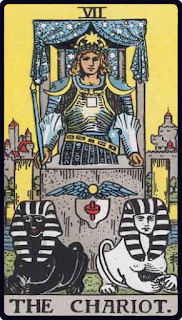
Representing escape, freedom, liberty, and our saving grace; the Chariot is often interpreted as a way out of our current situation and subsequently serves as a means rather than a destination. The Chariot can signify change after a long period of stagnation, but crucially whilst the place the chariot delivers us to is often assumed to be better this is not a guarantee. A word of caution should be given and the querent should consider the consequences of their actions before making commitments.
In the upright state our focus should be placed on the creation of exit strategies and fall-back positions; we are asked to consider our goals and plan ahead by identifying alternative paths that can be taken if necessary.
In the inverted state this card instead shifts our focus away from the desire to escape and to consider the merit of staying put; to that end we are asked to consider the potential risks that could unseat us and plan ahead once more with strategies instead aimed at maintaining our position.
In the Rider-Waite deck the Chariot is depicted as a grey stone edifice which sits in the foreground between two cities in the anterior. Whilst some interpretations think of these structures as one single settlement, they are in fact two, representing the cities of Sodom and Gomorrah soon to be destroyed by God. Ahead of this destruction God sent two angels who met with Lot and his wife. The voice of God is represented by the Charioteer with the two angels represented by the two sphinxes at the foot the chariot.
Forewarning of the destruction of Sodom and Gomorrah, God spared Lot and his wife instructing them to flee that they may live and their seed be preserved in Lot’s two daughters. Afront the chariot can be seen a red linga representing lineage and generational power.
Our lives are littered with commitments that we make; some are thought out well in advance but others are made on the spare of the moment without considering their long-term impact. Whatever the origin of the commitments we have made, there should always be a way out if needed. For instance, when entering a marriage, we expect to make a life-time commitment but if things eventually go wrong then divorce is one of the options available to us as an exit strategy. While this is a life-changing decision, the same concept applies to commitments of lesser significance that we make.
A commitment made out of a feeling that no other choice exists is not a commitment that has a solid foundation. It is important here to recognise when a choice exists and when it truly does not, with a particular emphasis on the assertion that the ease or difficulty of making a choice does not change the fact that it remains a choice. You can be presented with a cake walk or a mountain to climb, just because the latter is an incredibly difficult option to pick does not negate the fact it is still a choice that you can make - it still remains an option.
The Chariot therefore can be a prompt to consider what other options you have in a situation and to think about the choices you can make if your main focus does not lead where you expect it to – even if those other choices may be incredibly difficult to make, this card serves as a prompt to consider them with sincerity.
Ask yourself “What would happen if I actually did that?” and consider whether the magnitude of your current situation and the burden you feel because of it is truly heavier than the disruption and the challenge you would face when choosing the alternative.

No comments:
Post a Comment
All comments are moderated before they are published. If you want your comment to remain private please state that clearly.